Hua C., Wong R. Differential Equations and Asymptotic Theory in Mathematical Physics
Подождите немного. Документ загружается.


122
Question
2.7.
Using techniques in computational geometry, investigate
how the topology of
R
influences the geometrical ball-packing characteriza-
tion given in Proposition 2.10 for a k-spike solution of (2.46) with k large.
Can one estimate the number of solutions for
E
small but fixed?
In
[loll
,
a multi-dimensional extension of the projection method, as
outlined in Sec. 2, was used to determine an interior spike location. We
now sketch this method for a one-spike solution of
E~AU
+
Q(u)
=
0
,
5
E
R;
E~,U
+
b(u
-
S)
=
0
,
x
E
do.
(2.53)
Here
R
E
B2,
and
b
=
b(6)
2
0,
where
6
is
arclength along the smooth
boundary
dR.
We look for an interior one-spike solution of the form
u
N
w
[~-'lx
-
xol]
+
R,
where
R
<<
1.
Using the far-field behavior of
w
in
(2.47b), we find that
R
satisfies
L,R=E~AR+Q'(~)R=o,
x~o,
(2.54a)
(2.54b)
Here
c
>
0
and
a
>
0
are defined in (2.4713).
Moreover,
r
=
Ix
-
x01,
i
=
(x
-
xo)/r,
and
fi
is the unit outward normal to
dR.
Next, we consider the eigenvalue problem
E
anR
+
bR
-c~1/2
re
-lI2
-'E-'r
[b
-
ai.fi]
.
LE4
=
A$
,
x
E
R;
-E&$
+
b$
=
0.
(2.55)
This problem has two exponentially small eigenvalues, where the corre-
sponding eigenfunctions
$j
for
j
=
1,2, have the form
$j
N
dZjW
[E-115
-
zol]
+
$Lj
,
j
=
1,2.
(2.56)
Here
$~j
is
a boundary layer function localized near
dR
that allows the
boundary condition in (2.55) to be satisfied. To estimate
Xj,
for
j
=
1,2,
we then
use
Green's identity for
$j
and
dxjw,
to derive
Xj
(axj
W,
$j)
=
--E
$j
(E
an
+
b)
[dZ,w]
d[
,
j
=
1,2
,
(2.57)
J,,
where
(u,
'u)
=
s,
u'u
dx.
In [101],
$~j
was calculated from a boundary layer
analysis, which then determines
$j
on
dR.
In this way, we get
00
for
j
=
1,2. Here
P
=
so
wI2pdp.
This surface integral defining
Xj
is
of Laplace type, and
so
can be calculated asymptotically in terms of the
points on
dR
closest to
20.
Therefore, it is clear that
Xj
for
j
=
1,2 is
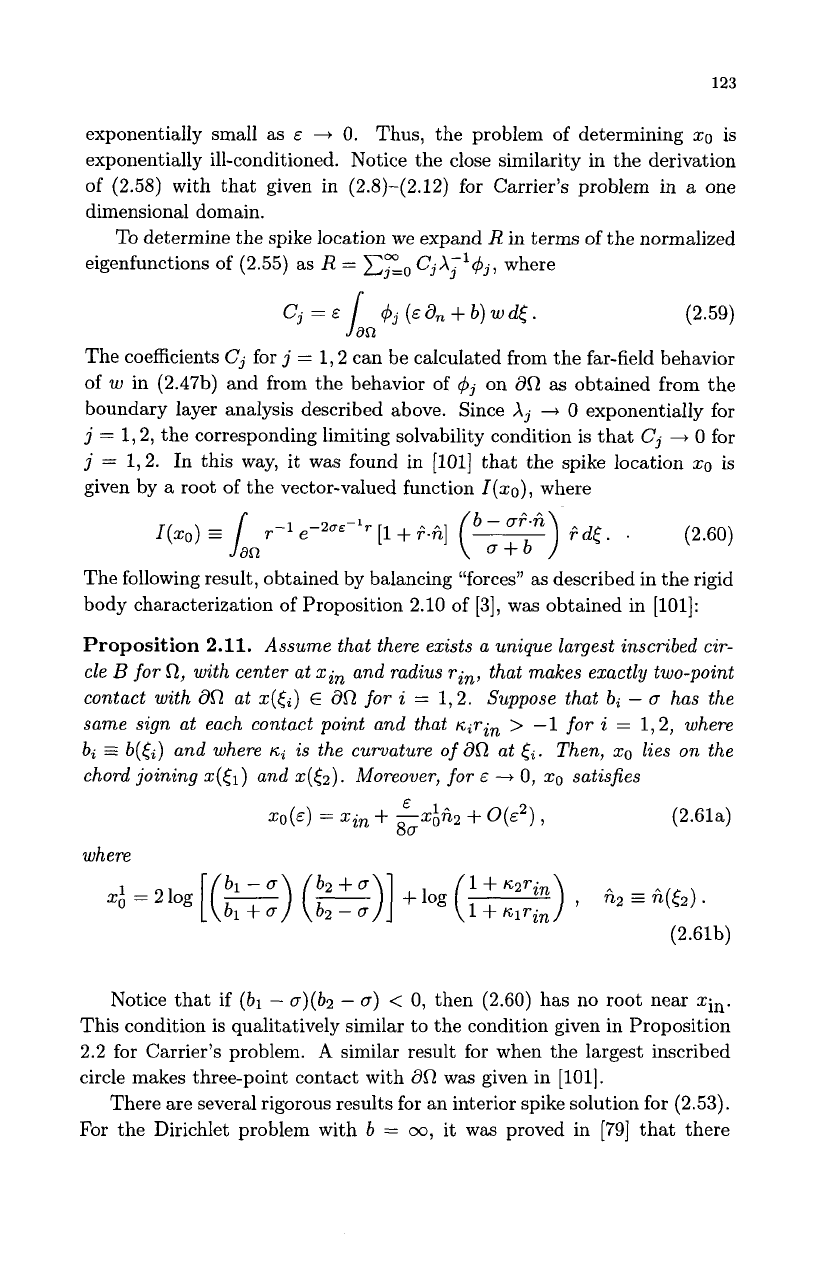
123
exponentially small as
E
4
0.
Thus, the problem of determining
xo
is
exponentially ill-conditioned. Notice the close similarity in the derivation
of (2.58) with that given in (2.8)-(2.12) for Carrier’s problem in
a
one
dimensional domain.
To
determine the spike location we expand
R
in terms of the normalized
eigenfunctions of (2.55) as
R
=
Czo
CjX?’q$,
where
Cj
=
.Jd,+j
(Ed,
+
b) wdc.
(2.59)
The coefficients
Cj
for
j
=
1,2
can be calculated from the far-field behavior
of
w
in (2.4713) and from the behavior of
$j
on
dR
as
obtained from the
boundary layer analysis described above. Since
Xj
-+
0
exponentially for
j
=
1,2, the corresponding limiting solvability condition is that
Cj
4
0
for
j
=
1,2. In this way, it was found in
[loll
that the spike location
xo
is
given by
a
root of the vector-valued function
I(xO),
where
(2.60)
The following result, obtained by balancing “forces” as described in the rigid
body characterization of Proposition 2.10 of
[3],
was obtained in [loll:
Proposition
2.11.
Assume that there exists a unique largest inscribed cir-
cle
B
for
R,
with center at
xin
and radius
Tin,
that makes exactly two-point
contact with
dR
at
.(ti)
E
dR
for
i
=
1,2.
Suppose that
bi
-
a
has the
same sign at each contact point and that
tcirin
>
-1
for
i
=
1’2,
where
bi
=
b(&) and where
tci
is the curvature
of
dR
at
ti.
Then,
xo
lies on the
chord joining
~(61)
and
x(&).
Moreover, for
E
+
0,
xo
satisfies
E
Xo(E)
=
xin
+
-x;fi2
+
O(E2)’
8a
(2.6
1
a)
where
Notice that if
(bl
-
a)(b2
-
a)
<
0,
then (2.60) has no root near xin.
This condition is qualitatively similar to the condition given in Proposition
2.2 for Carrier’s problem.
A
similar result for when the largest inscribed
circle makes three-point contact with
dR
was
given in [loll.
There are several rigorous results for an interior spike solution for (2.53).
For the Dirichlet problem with
b
=
00,
it was proved in [79] that there
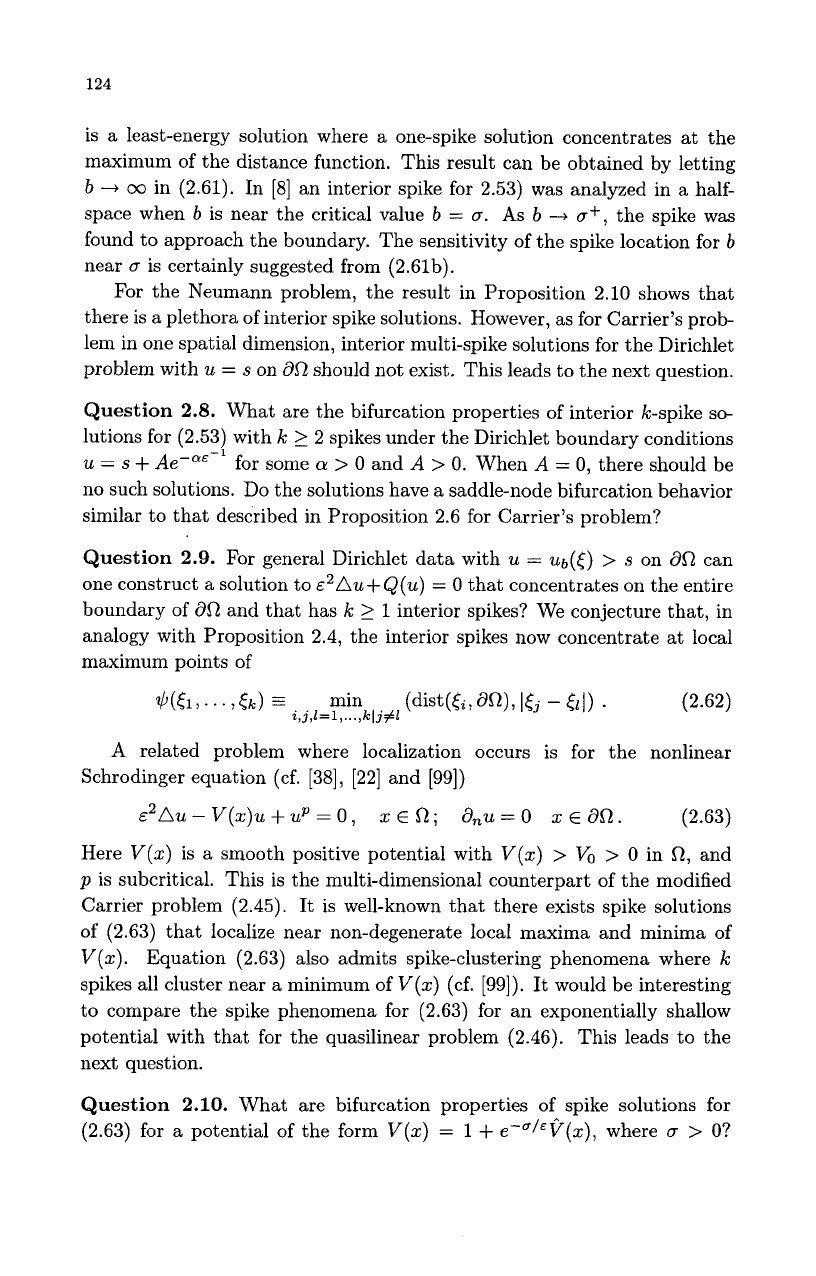
124
is
a
least-energy solution where a one-spike solution concentrates at the
maximum of the distance function. This result can be obtained by letting
b
-+
m
in (2.61). In [S] an interior spike for 2.53) was analyzed in a half-
space when
b
is near the critical value
b
=
rs.
As
b
-+
CT+,
the spike was
found to approach the boundary. The sensitivity of the spike location for
b
near
rs
is certainly suggested from (2.61b).
For the Neumann problem, the result in Proposition 2.10 shows that
there is
a
plethora of interior spike solutions. However, as for Carrier's prob-
lem in one spatial dimension, interior multi-spike solutions for the Dirichlet
problem with
u
=
s
on
dR
should not exist. This leads to the next question.
Question
2.8.
What are the bifurcation properties of interior Ic-spike
so-
lutions for (2.53) with
Ic
>
2
spikes under the Dirichlet boundary conditions
u
=
s
+
Ae-"€-l
for some
a
>
0
and
A
>
0.
When
A
=
0,
there should be
no such solutions. Do the solutions have a saddle-node bifurcation behavior
similar to that described in Proposition 2.6 for Carrier's problem?
Question
2.9.
For general Dirichlet data with
u
=
ub(J)
>
s
on
dR
can
one construct a solution to
~~nu+Q(u)
=
0
that concentrates on the entire
boundary of
dR
and that has
Ic
2
1
interior spikes? We conjecture that, in
analogy with Proposition 2.4, the interior spikes now concentrate at local
maximum points of
(2.62)
A
related problem where localization occurs is for the nonlinear
Schrodinger equation (cf. [38],
[22]
and
[99])
€2Au-V(Z)u+uP=O,
zER;
a,u=o
ZEdR.
(2.63)
Here
V(z)
is
a
smooth positive potential with
V(z)
>
V,
>
0
in
0,
and
p
is subcritical. This is the multi-dimensional counterpart of the modified
Carrier problem (2.45). It is well-known that there exists spike solutions
of (2.63) that localize near non-degenerate local maxima and minima of
V(z).
Equation (2.63) also admits spike-clustering phenomena where
Ic
spikes all cluster near a minimum of
V(z)
(cf.
[99]).
It would be interesting
to compare the spike phenomena for (2.63) for an exponentially shallow
potential with that for the quasilinear problem (2.46). This leads to the
next question.
Question
2.10.
What are bifurcation properties of spike solutions for
(2.63) for
a
potential of the form
V(z)
=
1
+
e-"/'V(z),
where
rs
>
O?

125
The spike locations should be determined from a competition between the
distance function and the localizing effect of the potential
p(x).
Another problem where localization occurs is in the construction of hot-
spot solutions
for
Bratu's problem
Au+Ae"=O,
XER;
u=O,
XE~R.
(2.64)
Here
0
is
a
bounded, simply-connected, domain in
R2.
The qualitative
feature of hot-spot solutions is that
u
4
00
as
X
4
0
in a localized region
near some
x
=
i$,
for
j
=
1,.
.
.
,
k
while
u
=
0(1)
as
X
4
0
away from
these points. Using complex analysis, a system of equations for the hot-
spot locations
&,
for
j
=
1,
..,
k,
was derived in [75]. An alternative method
based on singular perturbation theory was used in [loll.
The following
result characterizes the hot-spot locations:
Proposition
2.12.
For
E
+
0,
the
hot-spot locations
61,.
. .
,&
for
(2.64)
satisfy the coupled system
Here
Gd(x;()
is the Dirichlet Green's function, with
Rd(x;<)
as its regular
part,
so
that
and
1
Rd(X1
=
Gd(x,
e)
+
1%
Ix
-
El
.
(2.67)
Therefore, the criteria determining the hot-spot locations for (2.64) is
very different from that given in Proposition 2.9 for the spike locations of
(2.46). This difference arises from
a
logarithmic, or Coulomb-type, singu-
larity in the far-field behavior of the local hot-spot profile (cf.
[loll).
For
a
one hot-spot solution, the hot-spot location satisfies
VRd(x;&)
=
0
at
x
=
&.
For
a
convex domain
0,
Rd
is convex (cf.
[12]),
and
so
there is only
one hot-spot location. This criterion for
a
hot-spot solution with
k
=
1
is
actually very similar to the criterion developed in Sec. 4 that determines
the location of a spike for the full
GM
model (1.1).

126
3.
Spikes for Nonlocal Scalar Problems
In this section we begin by examining the stability of the equilibrium spike
solutions constructed in Sec.
2.
Consider the time-dependent problem
ut=E2Au-U+uP,
xER;
a,u=o
XEdR.
(3.1)
Here
R
is
a
bounded domain in
RN,
and
p
is a subcritical exponent.
Let
W,
be an interior one-spike equilibrium solution to
(3.1).
The center
of the spike
xo
satisfies dist(xo,
dR)
=
O(1)
as
E
4
0.
By linearizing
(3.1),
we find that the stability of this solution is determined by the spectrum
of
LE$€
E~A$E
-
$€
+
PW:-~$E
=
A"$,
,
an$€
=
0. (3.2)
Letting
E
-,
0,
and defining
y
=
E-'(x
-
xo),
we have that
w,
--f
w,
where
w((y()
satisfies
(1.7).
In this way, we obtain
L~$=A$-++~uIP-~$=x$,
$40
for
(yJ+00.
(3.3)
We refer to
LO
as the local operator, and
(3.3)
as
the
infinite-line local
eigenvalue problem.
The consequence of the exponential decay of
w(lyJ)
as
IyJ
00
is that
(3.3)
is independent of the shape of
R,
of
E,
and of
XO.
A
key result for
(3.3),
obtained in
[68],
is the following:
Proposition
3.1.
Consider
(3.3)
written as
Lo41
=
u$l
for
$1
E
H1(RN).
This problem admits the eigenvalues
uo
>
0,
u1
=
...
=
UN
=
0,
and
vN+k
<
0
for
k
2
1.
The eigenvahe
uo
is simple, and the corresponding
eigenfunction is radially symmetric with constant sign.
This result was proved in Theorem
2.12
of
[68].
Therefore, there is
exactly one unstable eigenvalue
uo
>
0
for
(3.3).
The eigenfunctions corre-
sponding to the zero eigenvalues are the translation modes
$j
=
dyjw(IyI)
for
j
=
1,. . .
,
N.
Each of these modes has exactly one nodal line.
In the one-dimensional case, the following more precise result for the
spectrum
of
(3.3)
was obtained in
[27]
using hypergeometric functions:
Proposition
3.2.
Let
J
=
J(p) be
a
positive integer such that
J
<
(p
+
l)/(p-
1)
5
J
+
1.
Then, for
$1
E
H'(R),
the infinite-line local
eigenvalue problem
Lo41
=
~$1
has
J
+
1
discrete eigenvalues given by
(3.4)
1
uj
=
4
[(p+
I)
-j(p-
1)12
-
1
,
j
=
0,.
.
. ,
J.
The continuous spectrum of
LO
lies
in
the range
-a
<
u
<
-1.
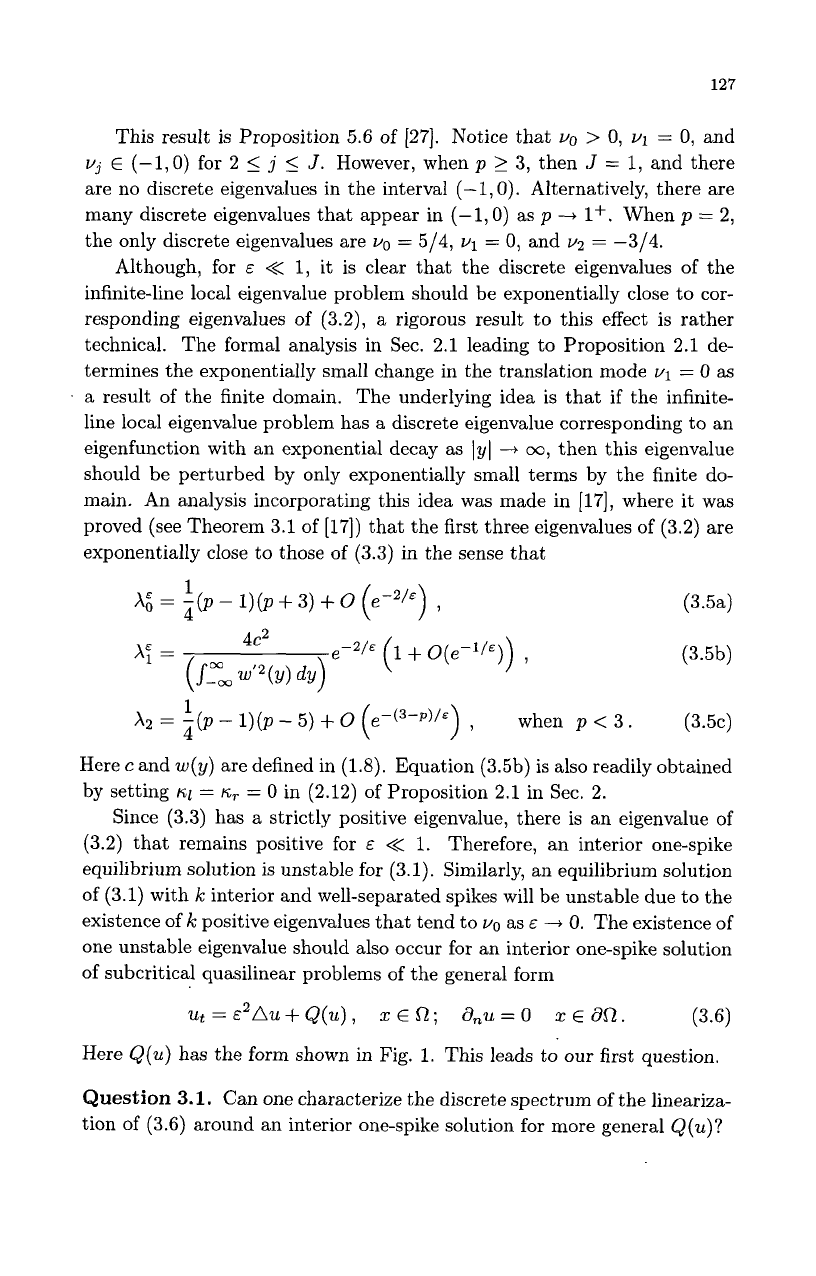
127
This result is Proposition 5.6
of
[27]. Notice that
vo
>
0,
~1
=
0,
and
uj
E
(-1,O) for
2
5
j
5
J.
However, when
p
2
3, then
J
=
1,
and there
are no discrete eigenvalues in the interval
(-1,
0).
Alternatively, there are
many discrete eigenvalues that appear in (-1,O) as
p
4
1+.
When
p
=
2,
the only discrete eigenvalues are
uo
=
514,
u1
=
0,
and
vz
=
-314.
Although, for
E
<<
1,
it is clear that the discrete eigenvalues of the
infinite-line local eigenvalue problem should be exponentially close to cor-
responding eigenvalues of (3.2),
a
rigorous result to this effect is rather
technical.
The formal analysis in Sec. 2.1 leading to Proposition 2.1 de-
termines the exponentially small change in the translation mode
v1
=
0
as
a
result of the finite domain. The underlying idea is that if the infinite-
line local eigenvalue problem has a discrete eigenvalue corresponding to an
eigenfunction with an exponential decay as
IyI
-+
00,
then this eigenvalue
should be perturbed by only exponentially small terms by the finite do-
main. An analysis incorporating this idea
was
made in [17], where it was
proved (see Theorem 3.1 of [17]) that the first three eigenvalues of (3.2) are
exponentially close to those of (3.3) in the sense that
1
A;
=
z(p-
(3.5a)
(3.5b)
A2
=
z\p
1,
-
l)(p
-
5)
+
0
(e-
('-P)/')
,
when
p
<
3. (3.5~)
Here
c
and
w(y)
are defined in (1.8). Equation (3.5b) is also readily obtained
by setting
KL
=
K~
=
0
in (2.12) of Proposition 2.1 in Sec.
2.
Since (3.3) has a strictly positive eigenvalue, there is an eigenvalue of
(3.2) that remains positive for
E
<<
1.
Therefore, an interior one-spike
equilibrium solution is unstable for (3.1). Similarly, an equilibrium solution
of (3.1) with
k
interior and well-separated spikes will be unstable due to the
existence
of
k
positive eigenvalues that tend to
vo
as
E
-+
0.
The existence of
one unstable eigenvalue should also occur for an interior one-spike solution
of subcritical quasilinear problems of the general form
tit
=
E'AU
+
Q(u)
,
x
E
s2
;
anti
=
O
x
E
80.
(3.6)
Here
Q(u)
has the form shown in Fig.
1.
This leads to our first question.
Question 3.1.
Can one characterize the discrete spectrum of the lineariza-
tion
of
(3.6) around an interior one-spike solution for more general
Q(u)?

128
Since (3.1) will not have stable equilibrium spike solutions, it is nat-
ural to
ask
whether stability can occur for systems of reaction-diffusion
equations that admit spike solutions. The simplest type of coupling in
a
two-component reaction-diffusion system is to consider the so-called shadow
limit where the diffusion coefficient of one of the species is taken to infinity
and the reaction-time constant for the same species is set to zero. Sev-
eral examples to illustrate this limit are given below.
Before discussing
these systems in any detail, we first illustrate qualitatively the mechanism
through which
a
spike can be stabilized by the shadow problem.
The shadow limiting process on
a
reaction-diffusion system typically
leads to
a
nonlocal scalar
PDE
of the form
ut
=
E'Au+
Q(u;uE)
,
x
E
0;
dnu
=
0,
x
E
80,
(3.7a)
uE
=
kg(u;E)dz.
(3.7b)
Suppose that (3.7) has a radially symmetric localized equilibrium solution of
the form
u
=
uq
(E-~(x
-
zol)
where
uq(lyI)
-+
s
exponentially as
IyI
00,
for some constant
s.
Here, we assume that
xo
E
D
with dist(x0,
dR)
=
O(1)
as
E
-+
0.
Then, the stability of this solution is determined by the spectrum
of the finite-domain nonlocal eigenvalue problem
E
&'Ah
+
QU&
+
Qu
gU4€
dx
=
A"$,
,
x
E
s1
,
(3.8a)
b
an4,=0,
XEdR.
(3.8b)
where the coefficients in the differential operator are evaluated
at
uq.
The
stability of the spike on an 0(1) time-scale follows if we can show that there
are no
0(1)
eigenvalues that satisfy Re(X)
>
0.
Since the coefficients in the
differential operator depend only on
y
=
E-~
Ix
-
xo
I
,
we look for localized
eigenfunctions
@(y),
which decay as
IyI
-+
00.
Therefore, it is natural to
try to compare the spectrum of (3.8) with that of
Mo@~A@+Q,@+Q,E~
g,@dy=X@,
YEV,
@.-to
y--+00.
(3.9)
S"
Here the derivatives are with respect to the
y
variable. This problem is
referred to as the infinite-line nonlocal eigenvalue problem.
We first note that the spectrum of (3.9) has
N
zero eigenvalues with cor-
responding eigenfunctions
@j(y)
=
ay,uq(JyI),
for
j
=
1,.
.
.
,
N.
For
these
functions the nonlocal term in (3.9) vanishes identically since
gu
is radially
symmetric in
IyI.
As
a result of the exponential decay of
up,
the discrete
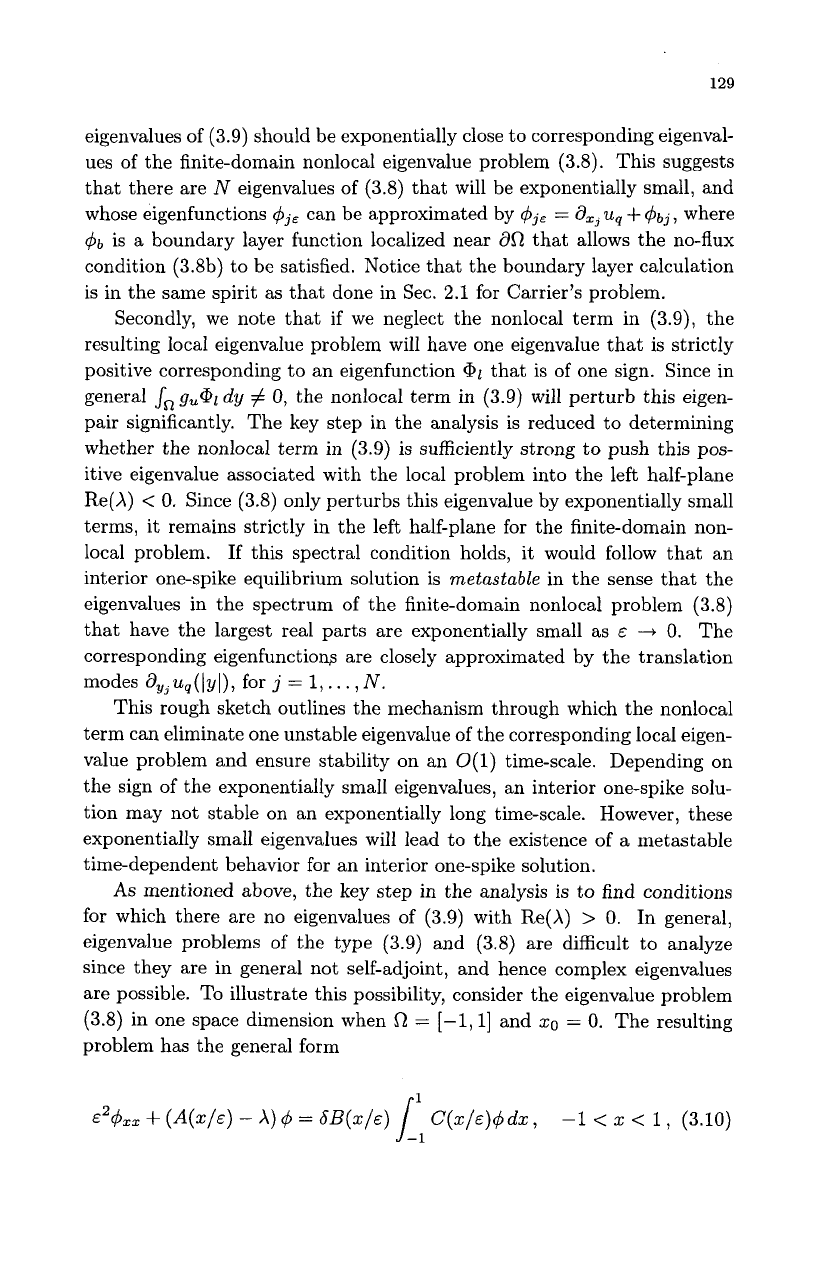
129
eigenvalues of (3.9) should be exponentially close to corresponding eigenval-
ues of the finite-domain nonlocal eigenvalue problem (3.8). This suggests
that there are
N
eigenvalues of (3.8) that will be exponentially small, and
whose eigenfunctions
$jE
can be approximated by
$jE
=
ax,
uq
+
$bj,
where
$b
is a boundary layer function localized near
dR
that allows the no-flux
condition (3.8b) to be satisfied. Notice that the boundary layer calculation
is in the same spirit as that done in Sec.
2.1
for Carrier’s problem.
Secondly, we note that if we neglect the nonlocal term in (3.9), the
resulting local eigenvalue problem will have one eigenvalue that is strictly
positive corresponding
to
an eigenfunction
@p1
that is of one sign. Since in
general
gu@pl
dy
#
0,
the nonlocal term in (3.9) will perturb this eigen-
pair significantly. The key step in the analysis is reduced to determining
whether the nonlocal term in (3.9) is sufficiently strong to push this pos-
itive eigenvalue associated with the local problem into the left half-plane
Re(A)
<
0.
Since (3.8) only perturbs this eigenvalue by exponentially small
terms, it remains strictly in the left half-plane for the finite-domain non-
local problem.
If this spectral condition holds, it would follow that an
interior one-spike equilibrium solution is
metastable
in the sense that the
eigenvalues in the spectrum of the finite-domain nonlocal problem (3.8)
that have the largest real parts are exponentially small as
E
-+
0.
The
corresponding eigenfunctiom are closely approximated by the translation
modes
dYJuq(lyl),
for
j
=
1,.
. .
,
N.
This rough sketch outlines the mechanism through which the nonlocal
term can eliminate one unstable eigenvalue of the corresponding local eigen-
value problem and ensure stability on an
0(1)
time-scale. Depending on
the sign of the exponentially small eigenvalues, an interior one-spike solu-
tion may not stable on an exponentially long time-scale. However, these
exponentially small eigenvalues will lead to the existence of a metastable
time-dependent behavior for an interior one-spike solution.
As
mentioned above, the key step in the analysis is to find conditions
for which there are no eigenvalues of (3.9) with Re(A)
>
0.
In general,
eigenvalue problems
of
the type (3.9) and (3.8) are difficult to analyze
since they are in general not self-adjoint, and hence complex eigenvalues
are possible. To illustrate this possibility, consider the eigenvalue problem
(3.8) in one space dimension when
R
=
[-1,1]
and
50
=
0.
The resulting
problem has the general form

130
with
&(fl)
=
0.
Here
S
is
a
parameter measuring the strength of the
nonlocal term. This eigenvalue problem is not self-adjoint unless
B(z)
=
kC(z)
for some constant
k.
For fixed
E,
many properties of self-adjoint
eigenvalue problems
of
the class (3.10) were obtained in [35] and
[9].
Consider the example
of
[50] where
E
=
1,
A(z)
=
0,
and
1
1
2
2
B(z)
2.5+~0s(nz)+2CoS(27r2)
C(Z)
~.~--COS(TZ)+-COS(~TZ)
.
(3.11)
Moveable eigenvalues are those eigenvalues of the local problem that are
perturbed by the nonlocal term. Fixed eigenvalues refer to those eigenvalues
of the local problem that remain independent
of
6,
since their eigenfunctions
are orthogonal to
C(z).
For this example, the only moveable eigenvalues
are those for which the eigenfunctions lie in the subspace spanned by
4
=
so
+
s1
cos
(7rz)
+
s2
cos (27rz)
,
(3.12)
for some
so,
s1,
and s2. Substituting (3.11) and (3.12) into (3.10) where
E
=
1,
we get the matrix eigenvalue problem
(A
-
bD)
s
=
As,
where
00
0
5.5 -1.25 1.25
A=
(0
-7r2
0
)
,
D
=
(2.2
-0.5 0.5)
,
s
=
(sn)
.
(3.13)
The real parts of the eigenvalues
as
a function
of
b
are shown in Fig. 4. In
this figure, the dotted lines correspond to the fixed eigenvalues -k27r2/4 for
k
=
1
and
Ic
=
3, corresponding to the eigenfunctions
q5
=
cos
(k7r(z
+
1)/2)
for
k
=
1,3. This simple example shows that nonlocal non self-adjoint eigen-
value problems of the form (3.10) can have complex eigenvalues through the
collision of two moveable eigenvalues.
An important class
of
nonlocal infinite-line eigenvalue problems that
arises in determining the stability of spike solutions in several different
systems is the following nonlocal non self-adjoint problem:
0
0
-4n2 2.2 -0.5
0:5
(3.14a)
Here
w(Jy1)
satisfies
(1.7),
and
Lo
is the local operator
Lo@
E
A@
-
@
+
pwp-la.
(3.14b)
We assume that
m
>
1
and
1
<
p
<
p,,
where
p,
is the critical Sobolev
exponent. Notice that
d,,w()y))
lies in the kernel
of
MO
for
j
=
1,.
.
.
,
N,
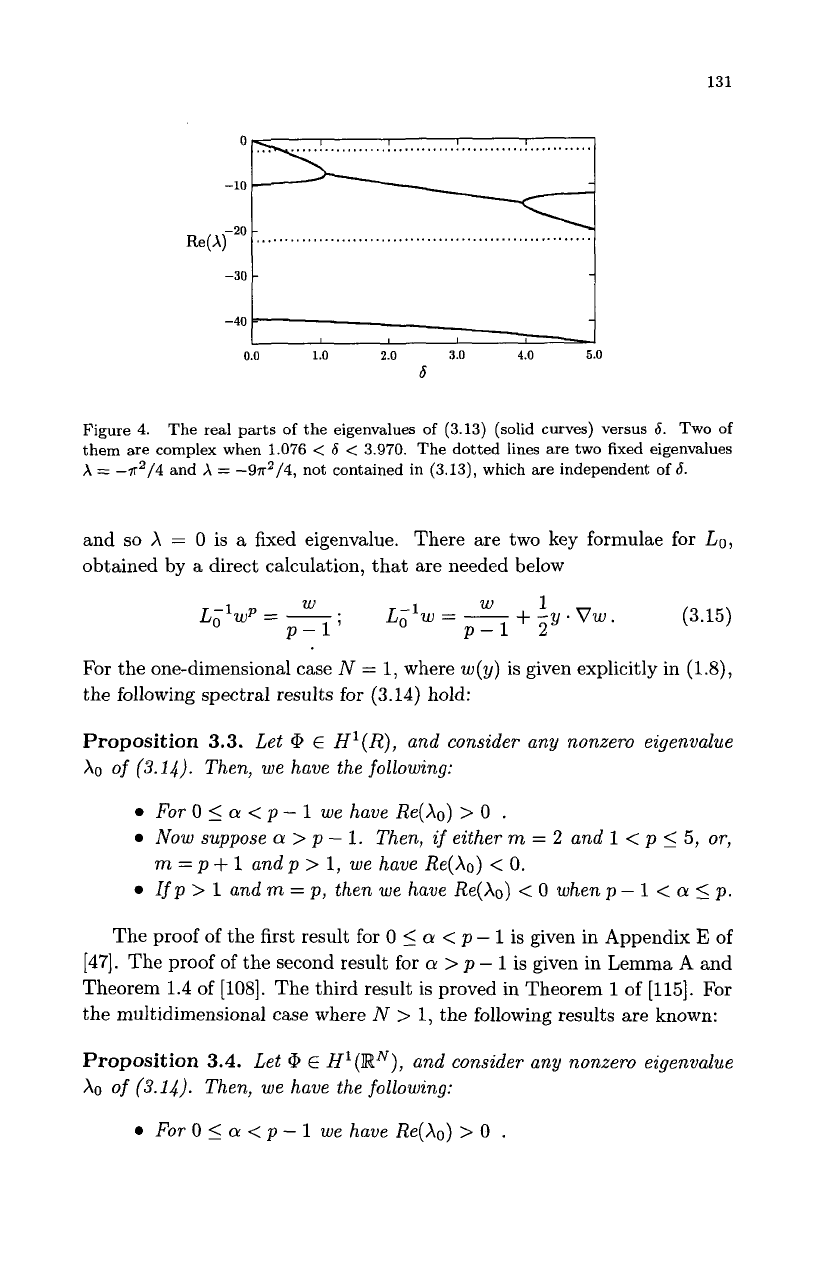
131
........................................................
Re($0
...........................................................
-30
t
1
-40
1
0.0 1.0
2.0
3.0
4.0 5.0
6
Figure
4.
The real parts
of
the eigenvalues
of
(3.13) (solid curves) versus
6.
Two
of
them are complex when 1.076
<
6
<
3.970. The dotted lines
are
two fixed eigenvalues
X
=
-7r2/4
and
X
=
-97~~14,
not contained in (3.13), which are independent
of
6.
and
so
X
=
0
is
a
fixed eigenvalue. There are two key formulae for
Lol
obtained by a direct calculation, that are needed below
(3.15)
For the one-dimensional case
N
=
1,
where w(y) is given explicitly in
(1.8),
the following spectral results for (3.14) hold:
Proposition
3.3.
Let
@
E
H1(R),
and consider any nonzero eigenvalue
A0
of
(3.14).
Then, we have the following:
For
0
5
a
<
p
-
1
we have Re(X0)
>
0
.
Now suppose
a
>
p
-
1.
Then,
if
either
m
=
2
and
1
<
p
5
5,
or,
If
p
>
1
and
m
=
p,
then we have Re(X0)
<
0
when p
-
1
<
Q
5
p.
m
=p+
1
andp
>
1,
we have Re(X0)
<
0.
The proof of the first result for
0
5
a
<
p
-
1
is given in Appendix
E
of
[47]. The proof of the second result for
a
>
p
-
1
is given in Lemma
A
and
Theorem
1.4
of
[log].
The third result is proved in Theorem
1
of [115]. For
the multidimensional case where
N
>
1,
the following results are known:
Proposition
3.4.
Let
@
E
H1(RN),
and consider any nonzero eigenvalue
XO
of
(3.14).
Then, we have the following:
For
0
5
Q
<
p
-
1
we have Re(X0)
>
0
.
